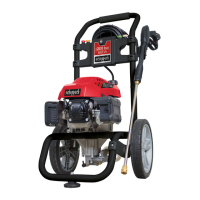www.scheppach.com / service@scheppach.com / +(49)-08223-4002-99 / +(49)-08223-4002-58
32
|
GB
Nozzle Maintenance (12)
A pulsing sensation felt while squeezing the spray
gun trigger (15) may be caused by excessive pump
pressure. The principal cause of excessive pump
pressure is a spray tip (12) clogged or restricted with
foreign materials, such as dirt, etc. To correct the
problem, immediately clean the spray tip (12) follow-
ing these instructions:
1. Shut o engine and turn o water supply.
2. Remove spray tip (12) from end of nozzle exten-
sion (4).
3. Use a small paper clip to free any foreign material
clogging or restricting spray tip (12) .
4. Using a garden hose, remove additional debris by
back ushing water through nozzle extension (4).
Back ush between 30 to 60 seconds.
5. Reinstall spray tip (12) lter into nozzle extension
(4).
6. Reconnect nozzle extension (4) to spray gun (2).
7. Reconnect water supply, turn on water, and start
engine.
8. Test pressure washer by operating with each
Quick Connect spray tip (12).
O-Ring Maintenance
Through the normal operation of your pressure wash-
er, o-rings are used to keep the connections of the
hoses and spray gun tight and leak–free. These
orings may become worn or damaged.
To remove a worn or damaged O-ring;
Use a small athead screwdriver to get underneath
the oring and pry it o.
Pump Maintenance
Changing Pump Oil (Fig. 10)
Change oil after rst 50 hours of operation and then
every 200 hours or 3 months, whichever occurs rst.
Note: When changing pump oil, use only high quality
oil SAE 30 without cleaning additive. Use no special
additives. Change pump oil as follows:
1. Clean area around brass oil drain plug at bottom
of pump (W).
2. Unscrew the oil tank cap with oil dipstick (20) by
turning counterclockwise and place a suitable oil
drain pan under the drain screw (W).Remove oil
drain plug (W). Drain oil completely into an ap-
proved container.
3. Unscrew the oil drain screw (W). Drain the entire
oil into an approved container.
4. When oil has completely drained, install oil drain
screw (W) and tighten rmly.
5. Add the recommended oil up to the “Max” mark at
the dipstick (typically 0.43L or 15 oz).
6. Install the oil tank cap with the oil dipstick (20) and
close it by turning clockwise.
7. Wipe up any spilled oil.
Cleaning Detergent Siphoning Tube
If you used the detergent siphoning tube, you must
ush it with clean water before stopping the engine.
1. Place detergent siphoning tube/lter in a bucket
full of clean water.
2. Engage safety latch on spray gun (14).
3. Attach black cleaning detergent nozzle (12).
4. Flush for 12 minutes.
5. Shut o engine.
6. ALWAYS point gun (2) in a safe direction and
squeeze spray gun trigger (15) to release retained
high water pressure.
IMPORTANT: Spray gun (2) traps high water pres-
sure, even when engine is stopped and water is
disconnected.
Automatic Cool Down System
(Thermal Relief)
If you run the engine on your pressure washer for
35 minutes without pressing the trigger on the spray
gun, circulating water in the pump can reach temper-
atures above 50°C. The system engages to cool the
pump by discharging the warm water onto the ground.
10. Pressure washer maintenance
Check and Clean Inlet Screen (Y)
Examine the screen (Y) on the water inlet. Clean it
if the screen (Y) is clogged or replace it if screen is
damaged.
Check High Pressure Hose (13)
The high pressure hose (13) can develop leaks from
wear, kinking, or abuse. Inspect the hose (13) each
time before using it. Check for cuts, leaks, abrasions
or bulging of cover, damage or movement of cou-
plings. If any of these conditions exist, replace the
hose (13) immediately.
Check Detergent Siphoning Tube (23)
Examine the lter on the detergent tube and clean
if clogged. The tube should t tightly on the barbed
tting. Examine the tube for leaks or tears. Replace
the lter or tube if either is damaged.
Check Gun (2) and Nozzle Extension (4)
Examine the hose connection to the spray gun (2)
and make sure it is secure. Test the trigger (15) by
pressing it and making sure it “springs back” into
place when you release it. Put the safety latch (14)
in the starting position and test the trigger (15). You
should not be able to press the trigger (15).

